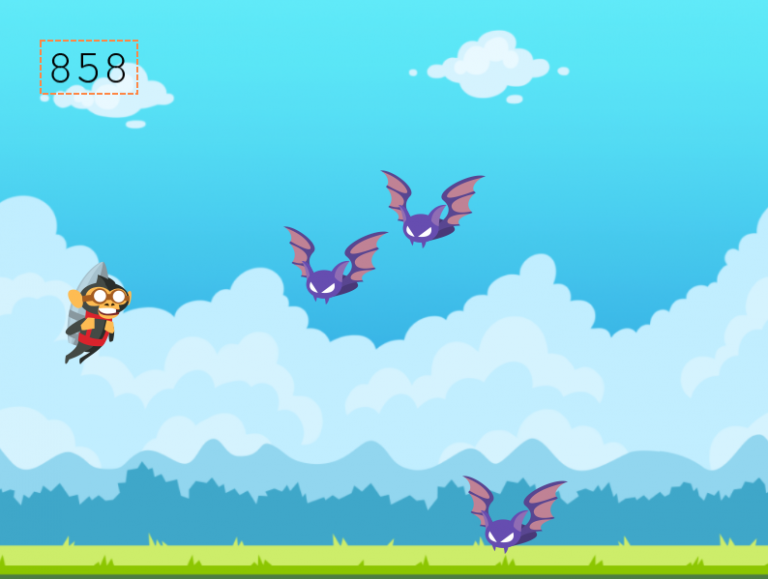When learning how to program computers, one of the first things that beginner coders encounter is strange and often confusing terminology. Traditional text-based programming, to be specific, is full of words and phrases that seem nonsensical and a touch intimidating. It doesn’t help that their definitions can be quite long-winded, too.
However, we firmly believe that language shouldn’t be an issue when learning how to code. Drag-and-drop block-based programming has proven that you don’t need to memorize hundreds of terms to build a program; you just need to know and understand the principles!
So, we’ve put together a reference sheet for over 70 common coding terms for beginners. These are all words and expressions that you’ll encounter eventually once you begin your coding journey.
Related Reading:
Before we begin, here’s a quick, summarized list:
Table of Contents
A
Algorithm
An algorithm is a sequence of instructions or a set of steps designed to solve a definite problem. For instance, adding several numbers together and then dividing them by the number of values to get the average. Finding the average is the “definite problem.” The steps you must go through to find the average – i.e., add all the numbers and then divide by the number of values – is the algorithm.
API
API stands for Application Programming Interface. It is a set of rules and protocols used to build software applications. APIs are also used to communicate with third-party programs or services to further develop existing software. For instance, developers use Facebook and Twitter APIs to gain easier access to the companies’ services.
Argument
Also referred to as arg in coding, an argument is a number, text string, or other value that is required for a command or function to run. Take this statement as an example:
f(x) = y
Here, x is the argument (or arg).
Array
Array refers to a list of similar data grouped together. All data and values in an array must be of the same type. For example, a class list can be considered an array because it’s all names. Similarly, the quiz scores of that class can be considered an array because it’s all numbers. So for instance:
SecondGradeResults = [4, 5, 5, 6, 7, 7, 7]
SecondGradeResults is the array, and it’s an array of numbers.
ASCII
ASCII stands for American Standard Code for Information Interexchange (ASCII). It’s a standardized system for electronic communication that consists of 128 numbers. All 128 numbers represent a specific letter and or symbol (like ‘$’ and ‘a’), and their meanings are the same all over the world.
Assignment Operators
These are used to assign a value to a variable. For instance:
- x = 8
The “=” is the assignment operator, assigning the value “8” to the variable “x.”
B
Blocks
Blocks refer to chunks of code that are used in block-based programming. Blocks are interactive coding elements that developers can simply drag and drop onto a scriptwriting platform to create a program.
Block-Based Programming Language
This is a visual programming language that uses blocks (see previous entry for the definition of blocks) instead of text to write programs. Block-based programming language is often recommended for kids and beginner developers who are completely new to the concept of coding.
Examples of popular platforms that use block-based programming language are Blockly, Scratch, and Scratch Jr.
Related Reading:
Boolean
Boolean expressions refer to “true or false” logic. They use AND, OR, XOR, NOT, and NOR operators with conditional statements, and they only have one of two possible values: TRUE or FALSE.
Boolean expressions are also called comparison expressions and conditional expressions.
Bug
This is something no developer enjoys encountering. A bug, in coding speak, refers to an unexpected error, defect, or miscalculation in the code of any hardware or software that causes it to malfunction. Bugs are what cause “glitches” in programming, and they can be quite difficult to find and fix.
Finding and fixing a bug in a code is called “testing” or “debugging.”
Build
In coding, “build” refers to the act of writing a program and then refining it so that it’s user-friendly. Developers can use special tools or third-party programs to create finished applications—aka “builds.” For a program to be considered a build, it must be fully coded, tested, and then debugged.
C
C++
C++ is a powerful programming language common in computerized electronic devices. It’s typically used to build fast programs. For instance, Adobe Photoshop and Adobe Premiere were developed using C++.
Call
There are two instances in coding wherein a “call” is used: to call a function and to call a variable. To call a function refers to a snippet of code used to make a function begin or run. To call a variable, on the other hand, is to use a variable somewhere in the current program.
Char
Char is short for “character” – a unit of information equal to one alphabetic letter or symbol i.e., “a”, “1”, “$”, and “X”. Any one of alphabetic letters or symbols can be considered the value of a char variable.
Class
A class is used in object-oriented programming to refer to a group of objects with common properties. For instance, a group consisting of 1 square, 3 triangles, 1 circle, and 2 pentagons can be considered a class of shapes.
Code
Code or source code refers to the written content of a computer program. A code is a set of instructions or protocols written in a language that a computer can understand. It tells the computer what to do, where to store information, and what to show the user.
Coding
Coding (also referred to as “scripting,” “developing,” or “programming”) refers to the act of writing a computer program. Coding is often the majority of what software engineers do.
Coding Language
As mentioned earlier, code is written in a language that computers understand—like C, Java, JavaScript, and Python. “Coding language” is the general term for such languages.
Related Reading:
Command
A command is exactly as described; an order that someone or something must carry out. In the case of coding terms, a command is an order for the computer. We use commands as often as we use computers. Some examples of common commands? Copy, Paste, and Print.
Compilation
This is a procedure in coding used to translate an existing piece of code into a computer-usable format. For instance, some coding languages are called “compiled languages” because they must go through the compilation process in order to be used.
Conditionals
Also referred to as conditional statements and conditional expressions, conditionals are elements of the code that help the computer decide what to do next. There are only two possible results to a conditional: TRUE or FALSE. They’re written following either an IF/Then format, an IF format, an IF-Else format, a While format, or an Else-IF format. For instance:
if a = 1
then a + b
else a – b
This means that the computer will only add “a” and “b” if the value of “a” is 1. If it’s any other value (like 2, 5, or 8), the computer will subtract it from “b.”
Constants
In coding, constants refer to any number, symbol, or text string that never changes value while the program it’s used in is running. Whereas variables can increase or decrease in value, a constant’s value stays consistent.
CSS
CSS stands for Cascading Style Sheets. It’s a popular type of code that typically dictates the appearance of a website i.e., the font face, the colors, the margins, the graphic elements, and so on.
D
Data
Data refers to any information that is (or can be) stored or processed by a computer via a computer program. This information exists digitally as binary units, a system of ones and zeros that only computers can read. However, when digital data is retrieved by users, the data appears in human-readable format (like names, addresses, and phone numbers, for instance).
Data Structure
Data structures are the formats used by a computer program to store, manage, and organize digital data. These structures make it easy for programs to access and retrieve data when needed.
Data Types
A data type refers to the kind of information a variable or constant can hold. This acts as its classification as well. Computers cannot distinguish the difference between a name (alphabetical characters) and a number (numerical characters). So the classification helps it understand and process the information accordingly.
Common classifications include strings, integers (numbers), Booleans (or TRUE/FALSE statements), and characters (alphabetical letters).
Database
In programming, a database is a kind of digital vault that stores data and information. Databases are typically represented visually as tables in a spreadsheet. For instance, a website would have a database where it stores usernames and passwords.
Debugging
Debugging is an important part of the programming process. Before developers can declare a code finished, they must painstakingly look for and repair any coding errors – or bugs – that cause the script to malfunction. This is called “debugging.”
Declaration
This is a single word, symbol, or statement used to describe a function or variable. Declarations define the type of variable or function so that the compilers, interpreters, or other developers know what to do with it. However, do keep in mind that declarations are optional and may or may not be used depending on the nature of the programming language.
Drag and Drop
The term drag-and-drop is typically used in block-based programming, wherein coders select a block of code by left-clicking on it and, while holding the mouse button down, dragging it to the main writer or scripting platform. They then release the block of code – or “drop” it – by releasing the left mouse button.
E
Else Statements
In section C, we mentioned “conditional statements” and how they’re written following different formats (if, else, and while formats). An else statement is an example of a conditional statement that essentially tells the computer: “do this if A is true, and do that if A is not true.”
Using the same example from earlier:
if a = 1
then a + b
else a – b
The else statement here tells the computer to “subtract a from b” as long as a does not equal 1.
Endless Loop
An endless loop – also referred to as an infinite loop – is a snippet of a program or code that continuously loops. As the name suggests, this snippet does not end unless acted upon. In most cases, it loops because the condition it depends upon is always true. Endless loops are usually bugs and must be taken care of – i.e., ended – immediately for a program to work properly.
Event
An event is a coding term that refers to a program response trigger. For instance, pressing or clicking a button.
An event handler, on the other hand, is the code that responds to the trigger aka the event. Take the act of clicking on a Refresh button to reload a webpage. The button being clicked is the event. The webpage reloading is the event handler.
Exception
Exceptions in coding refer to special, unexpected, and/or anomalous errors that happen when a program is run. These exceptions can alter the program and are typically caused by a user error or a missing piece of data. A common example of an exception is when a program tries to load a file but the file does not exist (because it’s been moved or deleted since the program last tried to access it).
Expression
Simply put, expressions in coding refer to arithmetic statements. For example:
- 1 + 2
- x + y
Expressions are defined as “legal groups” of alphanumeric symbols being used to represent the value of one or more variables.
F
F.A.I.L
F.A.I.L stands for First Attempt In Learning. This is a beautiful reminder that failing is a normal – and completely expected – part of the learning process.
For Loop
In coding, a loop – as the name suggests – refers to a chunk or block of code that repeats several times (hence the name) throughout the program. Developers must specify the number of times that part of the code – aka the loop – should repeat.
Framework
This refers to a foundation or template with a specified level of complexity. It can contain pre-written code, markup, and APIs that can then be altered and/or added on by a programmer. This makes it quicker and easier to build programs (compared to writing scripts from scratch) by allowing developers to ignore the general foundational scripts and focus on project-related specifics.
Function
A function is any block of code that takes input, manipulates it, and produces any form of output. It can be referenced by name and, after being created once, can be used over and over in the same script.
This is done using a function call—a short snippet of code that triggers a function to run.
When you write a function, you must call it (via a function call) to use it. The actual snippet or block of code that makes up the function is called the function definition. This is what makes a function work.
H
Hardcode
In coding, hardcode refers to a finished script or code that cannot be changed by a programmer or developer.
HTML
HTML stands for Hypertext Markup Language—a relatively simple language that uses easily understood keywords and tags. It is typically used to build basic websites. In terms of general page formatting, HTML determines the layout, style, and elements that show up on the page.
I
IDE
IDE stands for Integrated Development Environment. It is a program used by software developers to write code. These programs usually know a programming language’s keywords and can, therefore, help coders write, test, and run their programs as they build them.
An example of a well-known IDE is Visual Studio.
If Statement
An if statement is another example of a conditional statement. It tells the computer to run a certain snippet or block of code only if the specified condition is true.
Using the same example from earlier:
if a = 1
then a + b
else a – b
The if statement here tells the computer to “add a and b” if a equals 1.
Iteration
In coding, an iteration refers to the single pass of a loop (i.e., a block of code or a set of operations). Every time a computer runs the specified snippet of code in a program, it’s considered an iteration.
J
Java
Java is a popular object-oriented programming language typically used for web and mobile applications. It’s highly secure, concurrent (which means it can run multiple programs at the same time), and capable of running on any platform that is Java-enabled without needing to be edited. As a coding language for kids and beginners, Java is not as intuitive as some others. However, it is undoubtedly efficient and highly functional enough to be a top choice for developers.
Related Reading:
JavaScript
Like Java, JavaScript is also a popular object-oriented programming language for websites and web apps. It’s usually used for interactive elements and animations created in HTML (see section H). Some examples of JavaScript programming would be drop-down boxes and selectable radio buttons on online forms. This coding language runs “on the client-side,” which simply means that it runs in the browser instead of the computer (unlike Java).
jQuery
jQuery is a JavaScript library that makes it easier for third-party or independent developers to change JavaScript elements on a webpage.
JSON
JSON stands for JavaScript Object Notation, which is basically a Java-based file format that translates data to and from JavaScript into something readable.
L
Loop
Loops are one of the most basic – and the most powerful – coding concepts. They are elements in coding that refer to a block of code or a sequence of instructions meant to repeat several times. A loop will run over and over again until a condition is met and the program receives the order to stop.
Take for example a login page. The loop dictates that the user cannot move on to the next page until they enter the correct username and password combination. If the user enters the incorrect combination, the website will stay on the login page.
M
Machine Language
If you’ve ever seen those long combinations of zeroes and ones on a computer screen, that’s machine language. Also known as machine code, it’s considered the lowest level of programming language that consists of binary digits (numbers) that can be read by computers. However, despite that, all programs – no matter how refined or high-level – need to be converted to machine language in order to run.
N
Null
A null in coding refers to any element that is empty or has no value. For instance, variables, loops, functions, and columns in databases can be rendered null if they have no conceivable data in them. Take the following example:
$val1 = “”
$val2 = “3”
$val2 has a value of 3. But $val1, on the other hand, has a null value.
O
Object-Oriented Programming
Object-Oriented Programming (OOP for short) defines any form of programming or coding using classes (see section C) and objects. Typically, this style of programming centers on treating the code as sections of data, or “objects.”
Developers define the objects and group them into classes to use as single entities as they write the program. This makes it easier for coders to navigate, design, and refine larger, more complex programs.
Objects
These sections of data or segments of code are the foundation of object-oriented programming. They are essentially chunks that can be referenced, defined, and utilized during the process of programming. This is because the variables, constants, and other data structures that make up that object are related and can, therefore, be manipulated together.
Take a school class, for instance. In this example, the students that make up the class are the objects.
OS
You’ve probably heard people ask about the “OS” of your computer or your phone. OS stands for Operating System. This is the software installed in a machine that makes it work, organizes its files, and determines what programs can run on it. Popular examples of operating systems include Windows 10 and macOS.
Output
Output is simply the term used to refer to any content – digital or otherwise – that is produced by a computer. In coding, output could be text, numbers, images, audio clips, and videos.
P
PHP
One of the most commonly used scripting languages for websites, PHP used to stand for Personal Homepage. It now stands for Hypertext Preprocessor. It’s a general-purpose scripting language that uses tags like HTML (see section H) but is much more intuitive and user-friendly than HTML.
Pixel
Although this term doesn’t pop up in coding a lot (compared to the others on the list) it’s still worth noting. A pixel is the basic unit of digital displays. It’s a little square that’s one color, and it works with other similar squares to make up an image. The more pixels an image has, the sharper and more defined it will appear.
Programs
Defined as an “organized collection of instructions” that perform a specified task or function when executed, programs are basically the applications and games that are installed on your computer. Adobe Photoshop, Microsoft Word, Windows Image Viewer, Firefox, Google Chrome … these are all examples of very common programs that many of us use every day.
In terms of coding, programs are basically written codes that run on computers when prompted.
Programming
Programming (also known as coding) is the process of writing and building code that will, eventually, become a computer program. Processes such as designing, scripting, and debugging are considered a part of this process as well.
Programming Language
When developers write code for computer programs, they use specific keywords and follow specific rules. This is essentially what programming language is; a set of keywords bound by rules in order to make a program possible.
Python
Like Java and JavaScript, Python is a multi-purpose programming language used for building web applications and data analysis. It’s considered a very kid- and beginner-friendly programming language because it uses a simple syntax similar to the English language. In fact, many agree it’s much simpler to master compared to Java and C++.
Related Reading:
R
Run
To run a program basically means to start it or launch it. When you double-click the desktop icon for Adobe Illustrator or click the Hotbar icon for Google Chrome, you are essentially running a program.
Similarly, runtime (or execution time) refers to how long a program is running on a computer, from the moment the program starts up to the moment it is closed by either the OS or the user. Runtime is a part of the life cycle of any program.
S
SASS
SASS – or Syntactically Awesome Style Sheets – is a scripting language related to CSS (see section C). It is interpreted into CSS and can, subsequently, help users create style sheets a lot faster than normal.
Scripting Language
A scripting language is basically a programming language that doesn’t need to be compiled or interpreted by a separate developer/coder/designer. An example of a popular scripting language is JavaScript.
Scripts
In programming terms, scripts are basically a short set of steps written out for a computer to follow. Scripts can be small programs that are part of bigger programs. For instance, a calculator can do multiple arithmetic operations: addition, subtraction, multiplication, division, etc. So it can perform addition, but that’s not the only thing it’s programmed to do.
Server
Servers refer to a host computer or machine. This basically means that the computer stores websites, data, and information that other people can then access via the internet. The host machine – aka the server – will still have the data regardless of a network connection. Other computers who aren’t acting as hosts will now.
Source Code
This basically refers to full code built by developers to become functional software. It’s a full set of instructions written using the keywords and protocols of a particular programming language (see Section P), later translated into machine language (see Section M) by a compiler.
Sprites
If you play a lot of computer or video games, then you’re probably familiar with sprites. Sprites is a term used to refer to the on-screen visual representation of the player, typically rendered in 2D or 3D fashion. They are animated computer graphics that can be moved via code, and the code is triggered via user input i.e., pressing buttons, moving analog sticks, selecting on-screen commands, and so on.
Related Reading:
Statement
In programming, a statement is a single line of code properly written in the programming language. Think of it as an order that only a computer can read and, therefore, carry out. Just like how people can perform actions when given instructions (ex. “move there, please,” “please return your book,” “don’t go there!”) that they can understand, a computer can perform a specific action if it’s clearly written and properly explained.
Coding statements can include textual characters, integers, and other symbols. For instance:
a = a + 5 + $
This is an example of a perfectly acceptable statement that a computer can understand.
Syntax
Linguistically speaking, the syntax is defined as the “grammatical structure of words and phrases to create coherent sentences.” It is also the study of how words and morphemes (basically linguistic elements like –ing, -en, and –er) are combined to form larger units.
Syntax in coding isn’t much different. It still pertains to the structure of a language—specifically, a programming language. Every programming language has its own set syntax or inflexible rules about the order of words and elements.
If there’s an error in the syntax (aka the dreaded syntax error response that developers are familiar with), the computer cannot understand the statement, declaration, class, or command.
T
Token
Tokens are single words or symbols that can be classified as keywords, identifiers, literals, and punctuators. In programming, they are the smallest individual unit of code. Take, for example, the statement:
a = 2 + b
In this statement, the “plus sign” is a token. The “equals sign” is also a token.
U
URL
You’ve probably encountered this term multiple times on the internet. URL stands for Universal Resource Locator. To put it as simply as possible, a URL is the text you type into the address bar in your browser to get to a website.
For instance, our website URL is https://codakid.com.
User Interface Design
The User Interface – or UI – is the blanket term for all the visual parts of a computer program. It’s what the user sees: text, font, layout, buttons, graphics, etc. UI design refers to the process of building all those visual parts for the computer programming.
V
Variable
A variable is a container. It holds a single value, such as a word, number, or text string that the developer can use throughout the entire process of writing the code. The reason these values are stored in variables is that they can change at a moment’s notice, making them difficult to find and reuse. Values in variables are akin to having different art materials stored in different boxes that are clearly labeled. If you need colored pencils, you won’t have to open each and every box.
Variable Types
Variable types refer to the kind of information (or value) a variable can hold. Here are the different types:
- Strings = words and phrases
- Char = short for character (see Section C)
- Int = short for Integer
- Double | Float = decimal numbers
- Bool = short for Boolean (see Section B), or TRUE or FALSE values
W
While Loop
A While Loop is a block of code that will repeat over and over (see Section L) as long as the condition it’s related to is true. Like If Statements (see Section I), while loops will check a condition and run if the condition is TRUE. The only way for the loop to end is if the condition is rendered FALSE.
Think of a timer. A timer stops when the digits read 00:00. So as long as the digits do not read 00:00, the timer will continue to subtract 00:01 from the time until it reaches 00:00. When the program checks the condition and sees that the digits do read 00:00, it will stop subtracting 00:01 from the total time and the loop will end.
X
XML
XML stands for Extensible Markup Language, a markup language (see Section M) that look and functions similarly to HTML. The difference is that XML files work outside of web browsers, too.
Give yourself a pat on the back if you made it this far–that was a lot to take in! Don’t worry; the terms and jargon may seem intimidating at first but the more you encounter them – and use them – the more you’ll understand them. As you continue to develop your coding skills, these seemingly-complicated terms will become second nature to you!
Related Reading:
Conclusion
If you made it to the bottom of this list, congratulations! You’ve covered a lot of ground on your coding journey! Just in case you need to check back on something here is the list below to help you navigate to a coding term faster.
Table of Contents
We hope this comprehensive list of coding terms for beginners helps you take your coding experience to the next level!















